Drip System for Hydroponics
Like aeroponics, the drip system is considered to be an advanced method of growing. But also like the aeroponic method, this is a simple method to learn.

In the drip system, the plants are placed into a tray usually above the reservoir. The nutrient solution is then pumped up through the tubing through drip emitters which then top feed the plants.
What can go wrong with a drip system?
The major problems you’ll have are usually clogged drip emitters. So I will usually not recommend this method for use with organic nutrients. However, there are some professional grade organic nutrients that work very well with sprayers and emitters.
When setting up a drip system make sure to keep an eye on how well this system is working.
Again as with aeroponics, vigilance is the key.
One method to determine if your drip emitters are working properly is to pick them up and watch the nutrient solution drip from them.
The way to tell you are getting enough is to use your finger and physically touch the top of the medium.
If it is sufficiently wet, then the chances are good that your plants are getting enough water.
Rock wool is the standard medium used for this type of system because it holds water very well.
So this is the medium I will recommend for you to use.
I know the drip system has worked well in the past and I personally have used it before, but to be honest, I’m personally not a huge fan of this type of system.
I do not consider it to be any better than any other type of hydroponic system, because it seems to be as complicated as the advanced systems but without the outstanding results you get with aeroponic or NFT systems.
Nevertheless if you still would like to learn how to use this method, here are a few options.
Method #1 Buy a brand new drip system

Because of the level of difficulty involved with method, I will usually recommend that novices buy a brand new set-up if you are truly interested in using this type of system.
A professionally built system is easier to set-up and you will need some time to gain experience before you go out and try to build your own system.
Method #2 Build your own drip system
This system will be built like the aeroponic system with a few different details.
Try to use a dark colored reservoir to prevent the light from reaching the roots.
Supplies:
drill
scissors or box cutter
air tubing
air stones
Drip emitters with tubing
1/2in drill bit
2in hole saw drill bit
air pump
water pump
black vinyl tubing
rockwool blocks
Reservoir
Reservoir Cover
clay pellets or diatomite rocks
Step by Step
Step 1)
Use hole saw to cut 2in holes along the top of the chamber. Place the holes about 2-6in apart. The amount of holes will be determined by the size of the chamber and the amount of plants you wish to grow.
Step 2)
Drill a 1/2in hole on each end of the top. One 1/2in hole will be for the tubing from the air pump and the cord from the water pump. The other will be for connecting the water pump to the manifold. Manifold will be placed on top of the chamber, but may also be placed inside the chamber.
Step 3)
Connect 1/2in tubing from water pump to the manifold. Connect drip tubing from manifold to the drip emitters. Connect about 1-2 drip emitters per plant.
Step 4)
Put 4in netted pots into the holes you made on the top of the chamber. Insert the plant into a 4in “pre-soaked” rock wool cube and place the cube into the 4in netted pots. Fill the remaining space with clay pellets, silica rocks or a mixture of both. Make sure to cover the top of the rock wool cube to prevent the light from reaching the wet cube.
Step 5)
Plug in the air pump and make sure the air is causing the water to bubble.
Step 6)
Plug in the water pump and make sure water is dripping out of the emitters and that there are no leaks in the system. Position drip emitters in place with drip stakes and set drip rate.
Step 7)
Put the top back on the chamber and enjoy the benefits of your own homemade drip system.
Keys to Success
The key to making this method work is to make sure you are paying attention to the drip emitters.
Make sure that they do not get clogged and that they have enough water flowing through them.
As I mentioned earlier, use your finger and physically touch the top of the rock wool to determine if the plants are receiving enough water.
As the plants grow the watering needs will change so you may need to occasionally hand water your plants to ensure they are getting enough nutrient solution.
But if your drip system is set-up properly then hand watering may not be necessary.
Again as with any method, vigilance is key. So make sure you check your plants and system on a regular basis.